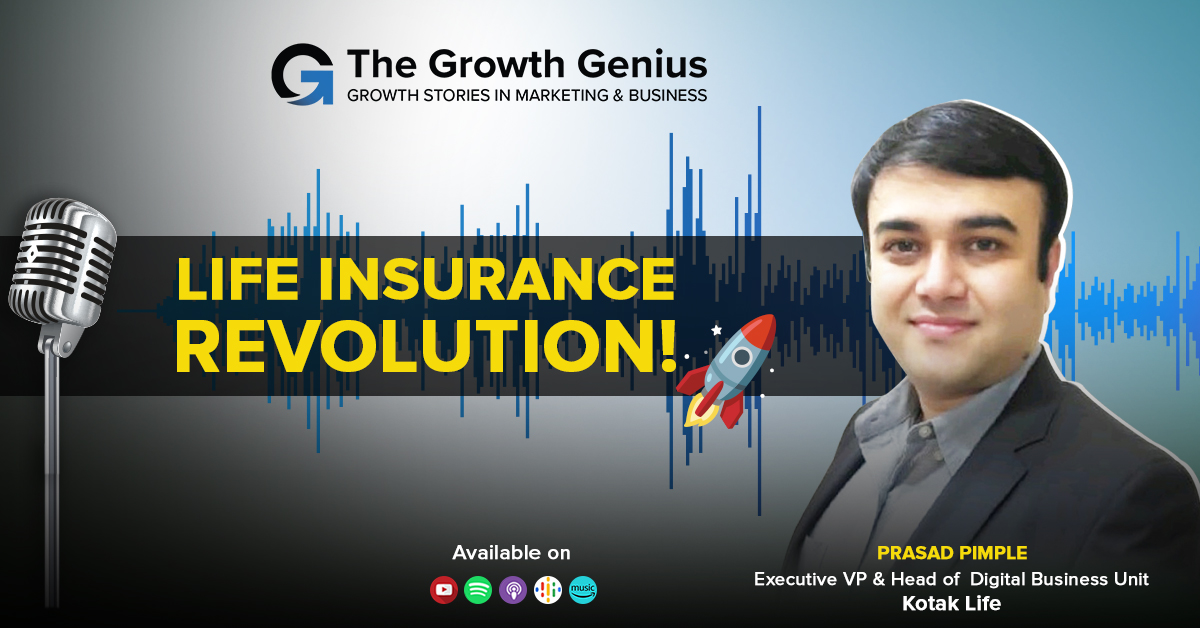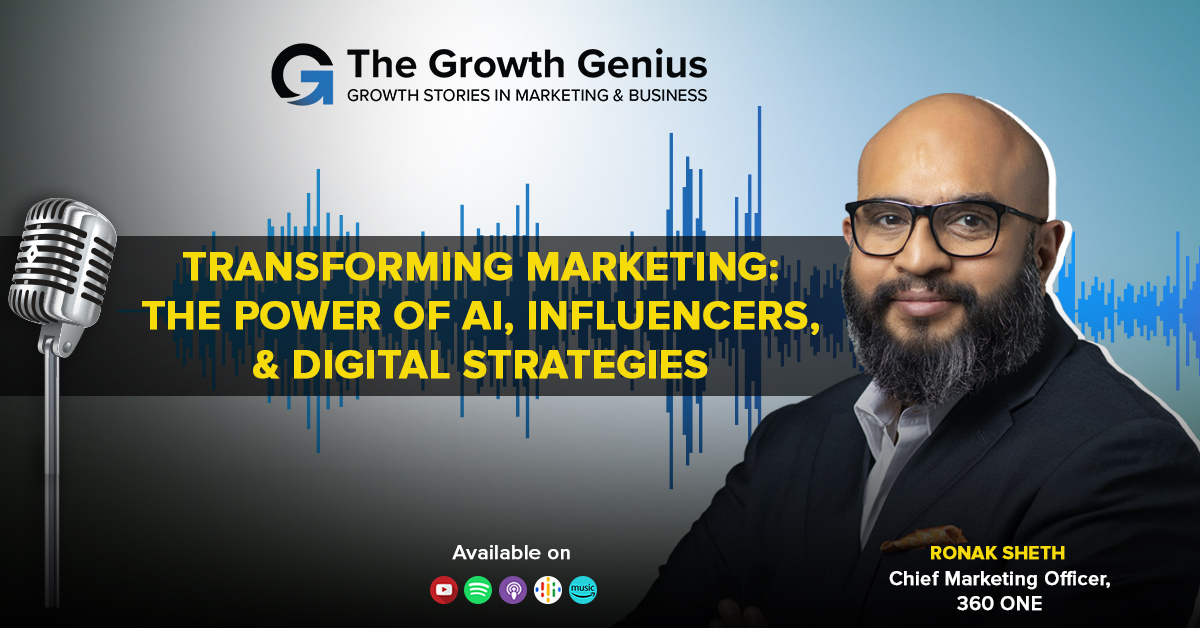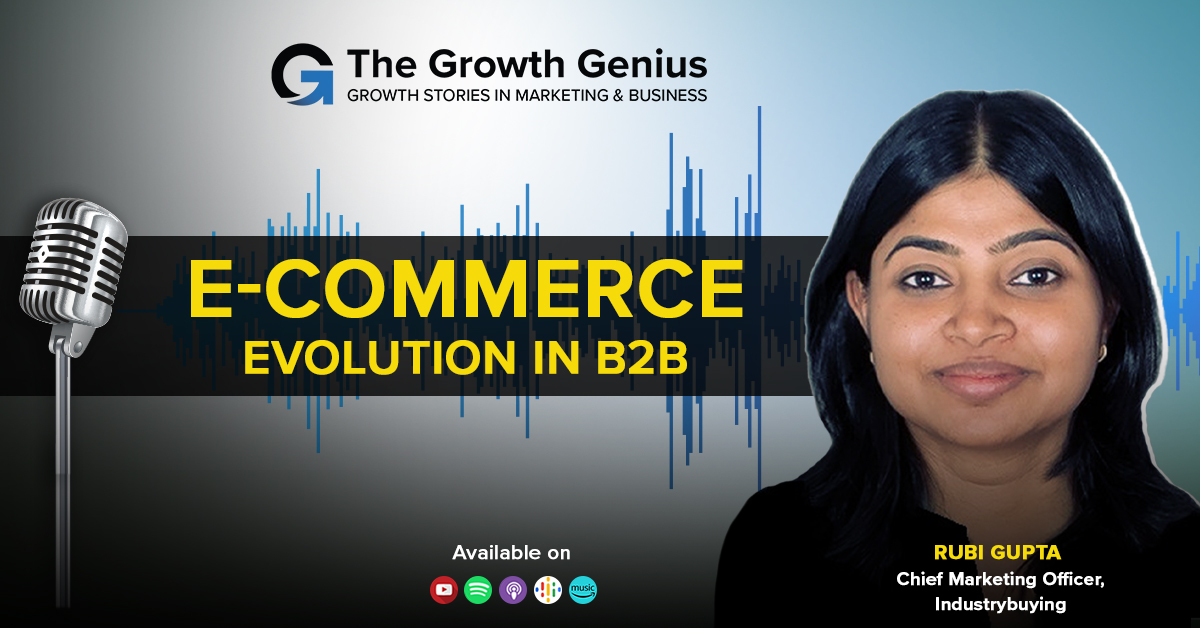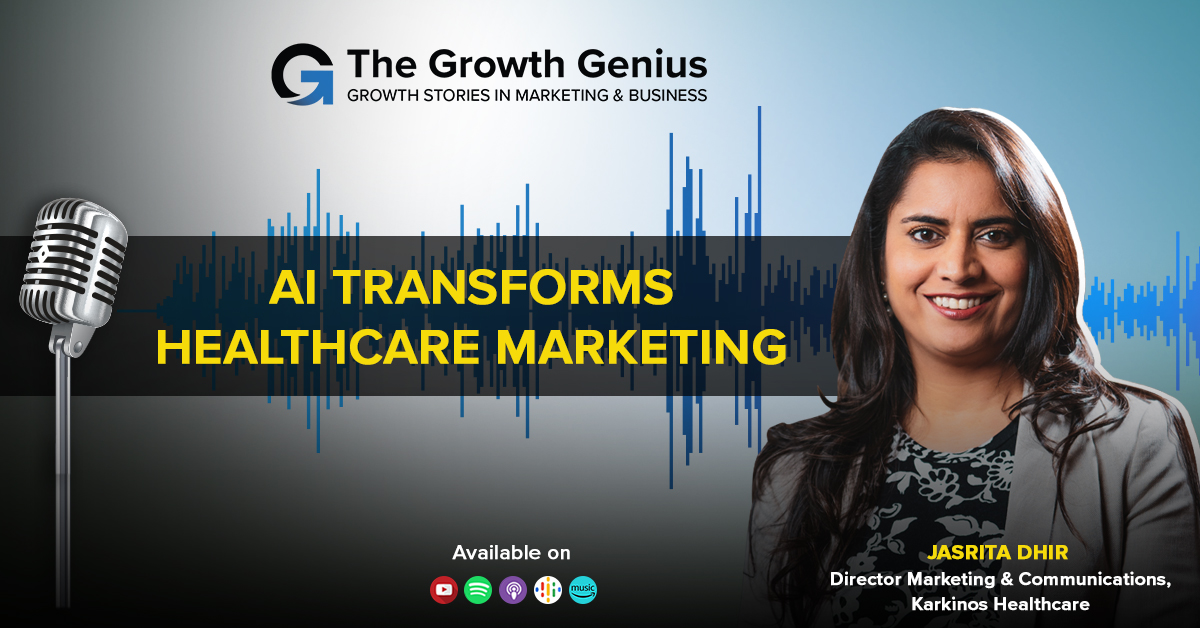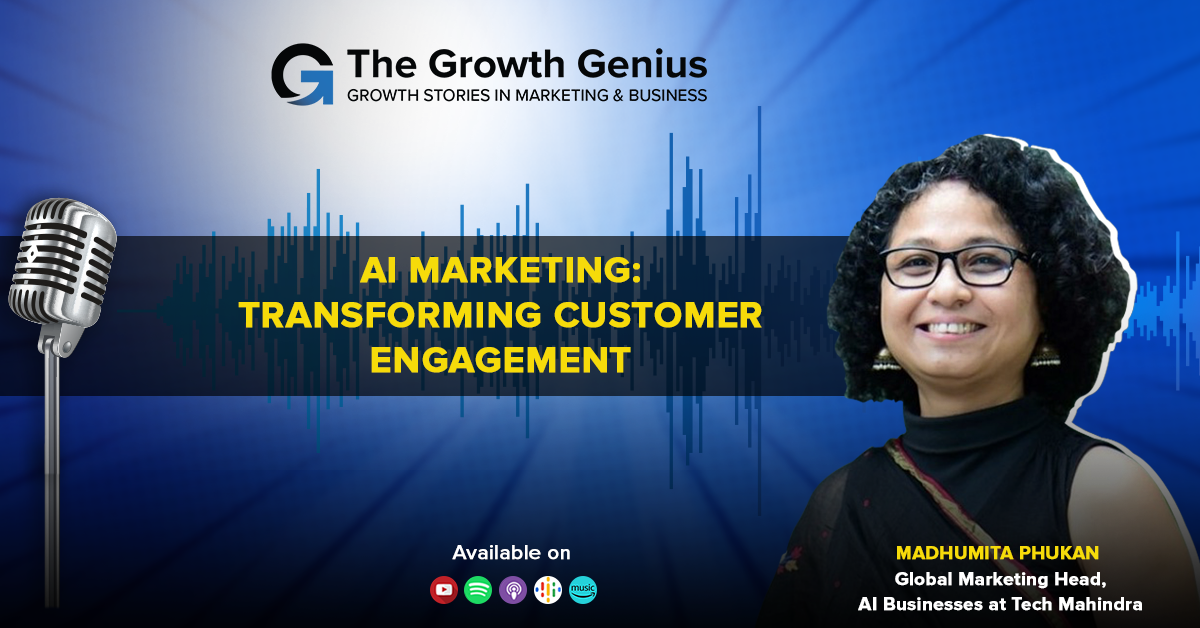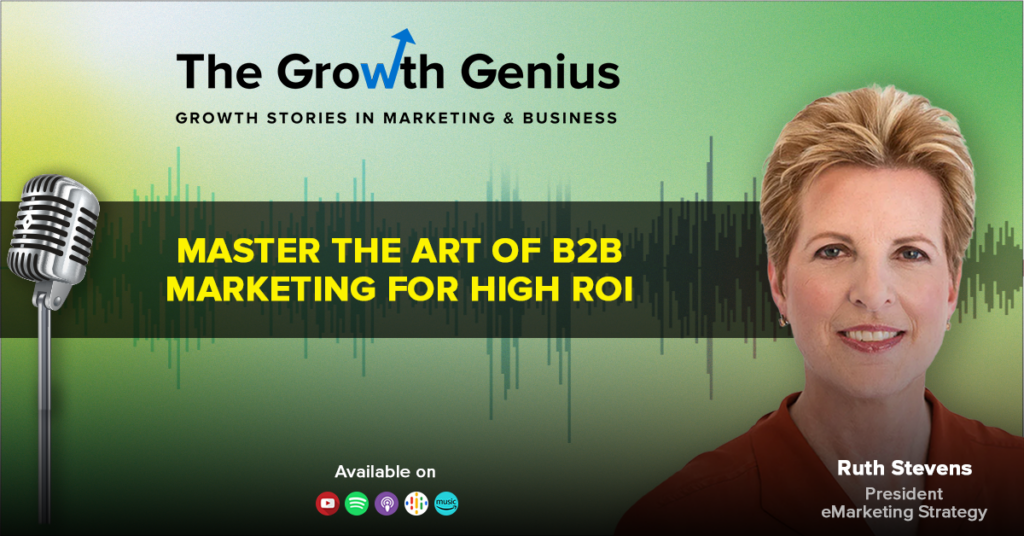
Witness an Increase in your ROI
Unlock higher rankings, quality traffic, and amplified conversions through tailored award-winning SEO strategies.
|
Getting your Trinity Audio player ready...
|
Listen on your Podcast app
Summary
In this podcast episode, Ruth Stevens discusses effective e-marketing strategies. She emphasizes the importance of understanding customer behavior and leveraging data to create personalized experiences. Stevens highlights the significance of email marketing, stating that it remains a powerful tool for engaging with customers. She also emphasizes the need for a strong website and the use of search engine optimization (SEO) techniques to improve online visibility. Stevens suggests that marketers should focus on building relationships with customers through relevant and valuable content. Additionally, she emphasizes the importance of tracking and analyzing data to measure the success of e-marketing efforts. Overall, this podcast provides valuable insights and tips for developing a successful e-marketing strategy.
Key Take Aways
The blog “E-Marketing Strategy” by Ruth Stevens provides valuable insights for digital marketers. Here are eight key takeaways:
- Understand the customer journey: Map out the customer’s path from awareness to purchase, and tailor your marketing efforts accordingly.
- Leverage data: Utilize data analytics to gain insights into customer behavior and preferences, enabling you to make data-driven decisions.
- Personalization is key: Customize your marketing messages and offers to create a more personalized experience for customers.
- Optimize for mobile: With the increasing use of mobile devices, ensure your website and marketing campaigns are mobile-friendly.
- Embrace automation: Automate repetitive tasks to save time and improve efficiency, allowing you to focus on more strategic initiatives.
- Content is crucial: Develop high-quality, relevant content that engages and educates your target audience.
- Utilize social media: Leverage social media platforms to connect with your audience, build brand awareness, and drive engagement.
- Test and iterate: Continuously test and optimize your marketing strategies to improve results and stay ahead of the competition.
By implementing these key takeaways, digital marketers can enhance their e-marketing strategies and drive better results in today’s digital landscape.
Read Transcript
Ruth Stevens:- The Internet has changed the way business buyers behave, and naturally, the way business sellers behave, and you know the power of YouTube and TikTok combined has really driven the acceptance of video as a marketing communications tool. The Internet allows much more variety in terms of sound, graphics, motion, and even music. So, as I said, there’s nothing more efficient in the B2B marketing toolkit than a face-to-face event, where you can look someone in the eye and really have a conversation.
Shelly Singh:- Hello and welcome to The Growth Genius series, brought to you by DMA Asia and Infidigit. My name is Shelly, and I’m the country director, Americas, at Infidigit. I’m also the Co-Founder and Director of DMA Asia. In this The Growth Genius series, the world’s best marketers and business leaders are interviewed about the brands they have worked on, their successful campaign strategies, how they got noticed by their customers, and how they delivered better customer experiences to drive growth. Today we have a special guest, Ruth Stevens. President, eMarketing Strategy
Ruth Stevens consults on customer acquisition and retention Specializing in b2b markets, she advises companies on go-to-market strategy, sales lead generation, customer and prospect data, content marketing, and account-based marketing. Crain’s B2B Magazine named Ruth one of the 100 most influential people in business marketing. Ruth also teaches marketing at business schools in the US and abroad. She co-hosts the Marketing Horizon Podcast. Her new book is “B2B Data-Driven Marketing: Sources, Uses, and Results.” A very warm welcome, Ruth.
Ruth:- Thank you, Shelly. I sure appreciate the chance to chat with you today.
Shelly:- Great. So, Ruth, you have been working in B2B for many years. How did you get into this field?
Ruth:- Well, I started my career at Book of the Month Club in customer acquisition for special interest book clubs. And after seven years at Time Warner, which was the parent company, I had an offer to move over to another publishing company called Ziff-Davis. And there I was asked to generate sales leads for subscribers too. You’re not going to believe this subscription product—CDROMs. Remember.
Shelly:- Yeah.
Ruth:- Right, that was sent out once a month, filled with information from the Ziff-Davis Computer magazines.
Shelly:- Wow!
Ruth:- And I just loved it from the first day there and learned b2b marketing from the ground up. But I was originally using the same database marketing techniques that I had learned at Time Warner. So it was a pretty seamless transition for me. And after that, I went to IBM, which was sort of the big time in b2b marketing, and learned even more there. So when I went out on my own later, about 20 years ago, I decided to specialize in b2b marketing as a way to differentiate myself as a consultant.
Shelly:- That’s wonderful. I guess you have seen a lot of changes over the years. What’s going on in B2B marketing today?
Ruth:- It’s changing really fast as a result of a couple of drivers, mostly the Internet, which has changed the way business buyers behave and, naturally, the way business sellers behave. And there’s a lot going on. COVID kind of accelerated those changes. For example, as you know, the business conference and trade show world, which has long been a very big part of the b2b marketing portfolio, was upended. And people have adapted to virtual events remarkably well, I think, to the point where even though we’re starting to reconvene in person, it’s clear that virtual versions of an in-person event, plus virtual-only events, have a place in the marketing toolkit. So that’s kind of additive and welcome as a result. I’m seeing that there’s a trend around what people are calling humanizing B2B.
Shelly:-Yes.
Ruth:-Meaning that our old way of thinking is that business buyers are buying on behalf of their companies, and they need a lot of data and a lot of ammunition to justify their purchase decisions. Lots of parties are involved in the buying of a b2b product or service, but at the same time, the humanity of the actual buyers is still there. They’re buying on behalf of their companies, but they’re still people. And also, that’s in parallel with the fact that brands, even boring industrial brands and scientific, highly technical brands, are realizing that making their own brand more human, accessible, and authentically positioned in the minds of the buyers is helpful. So marketers are putting their attention on that imperative, and it’s really paying off.
Another interesting thing that’s caught my attention is maybe a minor matter, but it’s about video as a media channel, and, you know, the power of YouTube and TikTok combined have really driven the acceptance of video as a marketing communications tool in all walks of life, even technical and industrial topics. So we’re seeing clever B2B marketers apply video at all stages of the buying and selling process. And it’s really exciting. It can be highly technical in its messaging, but it can also be fun and engaging. And of course, we know that compared to print, the internet allows much more variety in terms of sound, graphics, motion, and even music. So, video is a medium that is really taking off now in B2B; those are a couple of interesting trends.
Shelly:- So what we see is that the younger generation today doesn’t like to speak on the phone and prefers emails or messaging with their potential customers. So are we facing the death of the traditional salesperson?
Ruth:-This is really a subject of great conversation in the b2b world right now because salespeople have for many years now been losing control of the buyer, who is of course researching online. And this means that we marketers are stepping in to satisfy those researchers and make sure that our solutions are findable, that we’re being helpful and educational, that we’re not being overly promotional, and that we’re helping them solve their problems. And the salespeople’s role in the buying process has been reduced in a way because they’re often most productive at the tail end of the journey or the process that the buyers go through, to the point where some observers are saying as much as 85% of the buying process is accomplished before a salesperson is ever even brought into the conversation. Now, that’s not going to be true everywhere, but it’s definitely a direction. And another corollary is that b2b buyers, in some respects, are getting more and more comfortable conducting transactions online, meaning e-commerce. At least pieces of the buying process are there and are enabled by e-commerce today. It’s always been a sales tool for very simple products, like office supplies, toner, paper, and so forth, through e-commerce. But when it comes to a complex solution, they really want to talk to a salesperson. So the current thinking is that a sales professional’s involvement will still be required into the long future, as will the availability of technical salespeople to help the buyers make a decision and get whatever product or service they’re buying installed and working in their labs, in their IT departments, or wherever it is. There’s an argument to be made that it’s a career that is not going to need as many human resources as it used to.
Shelly:-Wow. That’s very good and bad, right?
Ruth:- Yeah. I do argue, though, that people buy from people they like and respect. So realistically speaking, it’s unlikely that a large enterprise is going to make a multimillion-dollar purchase decision without talking face-to-face with a representative of the supplier firm.
Shelly:-So what happened to the relationship building then? Because in B2B, it’s very important to build relationships, right?
Ruth:- Yes, and that’s where this trusted relationship really plays a role and why business sellers have long been really focused on that, you know, with entertainment and getting to know you. And a great salesperson will spend most of his or her time building a relationship through golf, dinners, trips, and so forth, knowing the names of family members and all that. At the same time, the relationship is still important. It’s different. And interesting for me as a marketer is to watch how marketing is getting more human by kind of stepping into that gap where our marketing communications need to fill in and where the salesperson is not involved. We have to pick up that piece of the process and build that trust using other methods. And that’s why interactive tools, social media, chatbots, video, and these more human messaging channels are becoming a bigger and bigger part of the b2b toolkit.
Shelly:- So my next question is, What is the most effective channel for b2b marketing? Do you think that SEO can play a very important role in generating quality leads?
Ruth:- Yes, indeed. Well, lead generation is always job one for a marketing department in B2B. It’s probably going to be that way forever. Although the changes in the buying process and buying behavior are overall getting us to the point where marketing has a much bigger portfolio to attend to, It’s less of a marketing strategy that generates a lead and tosses it over the transom to the salesperson, who then follows up. Marketing is actually involved earlier and deeper in the relationship now. There is no single channel that is a standout, but if you asked me what the must-have channels are in b2b, I would still begin with the website and make sure that our company website serves the needs of our target audience. It provides information that helps them solve their problems and helps them recognize us as a trusted helper and a reliable partner. It also needs to be interactive so that it’s not just what they call brochure-wear; it engages them. This is why chatbots, especially the modern ones, allow a lot of functionality to convert a visitor to a data element or a data point, for example. I wouldn’t call it a lead yet, but I definitely want to have tools that de-anonymize the website visitor. One of these, of course, is looking at the IP address of the visitor and making note that a certain account has visited the site, assuming they’re coming from their corporate browser. And one way—the most effective way—to de-anonymize is to make an offer. This is Direct Marketing 101. Usually it’s a piece of irresistibly important and useful content that, in exchange for filling out a web form, the visitor will download, and we get the name and contact information, and the visitor gets the valuable piece of content. But also, as I said, IP address identification and using chatbots and other tools to try to make the website interactive and highly searchable
Many industries have a lot of complex information to provide to buyers, and if the search engine on the website is inadequate, that will frustrate visitors. So the website is like the basic-owned medium of the seller, but these days, interestingly, social media are more important than ever, especially as the buyers are younger and younger and entering the buying circle at the customer end from the position of being digital natives, unlike people of my age who arrived at the internet later in life. It’s imperative for b2b marketers to recognize that even though we think of social media as mostly social and not business other than LinkedIn, this is where our customers and prospects are, so we have to be there. And then, once those two are covered, search engine optimization and search engine marketing would be where I would focus in digital terms.
B2B events, though, have always been a big part of the mix. And now that in-person events are coming back, that’s another area that I would not neglect, because it allows the relationship to be developed so much faster in a face-to-face environment like an event that you kind of leapfrog over probably months, maybe even years, of what it would take in digital channels to establish. I’m ducking your single most important question and giving you a whole plethora of them.
Shelly:- No problem. So this brings me to my next question: how can B2B brands stand out on social media? I used to reach out to my target audience through LinkedIn, which used to work so well, but now I’m seeing low response, and I’m getting this feedback that LinkedIn is becoming almost and the pandemic has massively escalated this. So what are your views on this? How can b2b marketers go beyond LinkedIn?
Ruth:- Well, in the social media context, LinkedIn is still the most valuable for many reasons. The marketing solutions available at LinkedIn, like InMail, and the ability to reach out to highly targeted prospects based on keywords just can’t be ignored, even if response rates are declining. By the way, Shelly, are you also noticing that LinkedIn’s kind of automated b2b LinkedIn management and lead-gen services are proliferating all over the place? I feel like I get an offer every day from somebody.
Shelly:- That’s the reason people are not checking their inbox; they’re not going on LinkedIn to check mail. There’s fear that there will be another sales pitch, and they know that it’s all automated.
Ruth:- Yeah, it is frustrating, and I’m sure the people at LinkedIn are concerned about this and trying to figure out how to increase or recover that quality of the experience. But as I said, other than LinkedIn, I argue that just about every social medium is worthy of our inspection.
Shelly:- In fact, Instagram is also doing pretty well.
Ruth:- Instagram and TikTok—it’s remarkable how our buyers are there, and we’ve got to be there too. Even if we’re selling pretty technical solutions or things you might think are boring, like accounting services and so forth. If our customers are there, we’ve got to be there too.
Shelly:- Yes, that’s right. I see this new wave of B2B marketers getting on TikTok, and it’s really wonderful how they are harnessing the power of TikTok as well.
Ruth: Yeah, it’s sort of hilarious, isn’t it?
Shelly:-Yeah.
Ruth:- And it’s part of what I was mentioning about the video: that the two are just feeding off of each other.
Shelly:- Yeah. Do you have some favorite campaign examples that you can share with us? Anything from your book or anything you have done or admire done by somebody else?
Ruth:- Sure. As a matter of fact, I went over to the bookshelf and brought out a copy of my most recent book, which, with the blur,is maybe a little difficult to see. But this book on B2B data-driven marketing, which was co-authored with Theresa Kushner, contains about a dozen case studies. And one of my favorites is the first in the chapter on case studies from a story actually from 2004 to 2008. It was a period of great change in the world of industrial machinery, and I happened to get acquainted with the US division of a very well-known Japanese manufacturer of machine tools. Now, not everybody knows what a machine tool is, so let me just explain it. Machine tools are intended to cut metal into precise shapes. So the big industries that use machine tools, at least high-end machine tools like this one from this company called Makino, are no surprise; they are companies that use a lot of metal in their manufacturing processes. So one would be automotive, of course, and the other would be aerospace, and then there are lots of smaller companies that use machine tools, like manufacturers of molds and dyes. Makino, being the producer of the most sophisticated, premium, high-end, and high-priced machine tools, reflective of the Japanese reputation for technical superiority and good quality, has a very large division in the US, calling on automotive and aerospace manufacturers. So it’s like Ford and Boeing or General Motors and Boeing; you could think about it. And in their traditional go-to-market process, they had about 125 salespeople and about another 100 agency reps or agents on the ground representing them. And they would support these sales forces with traditional b2b marketing tools, namely advertising and trade publications like Aerospace Weekly or whatever, the pubs in those industries, and trade shows. They were exhibiting at around 30 trade shows a year. So, they were everywhere, getting their technology in front of buyers in these two industries. And in the early 2000s, they realized that the market was changing and that they needed to change with it. And they realized that there was a lot of waste because the entire industry of machine tooling represents about 55,000 companies. But most of them, the fast bulk, like more than 70% of them, are mom-and-pop tiny shops, like if you go over to Queens and in the industrial area of Queens, you’ll see millions of them—well, not millions, but many mom-and-pop machine tooling shops. That’s not a customer for Makino. They’re really enterprise-premium sellers. So they realized that by advertising and exhibiting at trade shows, they were marketing to all 55,000, and they really needed to focus more clearly on the maybe 15,000 or so that would really ever be their prospective buyers. So they decided to build a marketing database. Tada! Doesn’t this make you happy, Shelly? They said we’ve got to be more laser-focused on our targets. So they built a database with a number of inputs. They actually bought data from the same trade publications that they had been advertising in. They had their own CRM system, meaning a Salesforce automation tool. They also used government documents. Well, you know, many industrial manufacturing products are registered with the Federal government for safety and other reasons. So it’s publicly available data on installations of machines in manufacturing. And they also went around to all their salespeople and said, Who do you want to see? Who’s your target customer? Who do you want there? And then ended up with several thousand. They also had a magazine, so the subscribers to their magazine So little by little, they built this marketing database and had it populated using database service companies with the names of the various individual contacts in those accounts that the salespeople and marketing people wanted to talk to. So these would be like factory people, finance people, and other titles. So that was one piece. And then the other thing they did was invest in content marketing. They were early adopters of the webinar, realizing that as the premium vendor of machine tools, their engineers were the best in the world. And so they asked their engineers to kind of get on a webinar and talk about the latest machine tooling techniques, turning those into webinars. In the beginning, they produced as many as three a month and posted them on the website. By the way, all of that content was gated by a web form, so if you wanted it, you had to give up your contact information. But to me, the most interesting angle of this whole story is that they decided to build a presence on Facebook. Now, when I first heard this, I said, What? Facebook is cat videos and grandmothers, Makes no sense at all. But, as a matter of fact, it turned out to be a huge success. And very rapidly, just in a matter of years, all of those webinars were being downloaded from Facebook. Well, they would be promoted on Facebook, and then to view them, you had to fill out the web form at the site. But they eventually had 100,000 followers on Facebook and became known as an enormous source of machine tooling education, to the point where in the professional schools like the engineering schools at Rensselaer Polytech, all these important places where engineers were learning about machining and other applications for tools like this, the professors would recommend that if you want to learn about machining, go to the Makino Facebook page.
Shelly: That’s great.
Ruth:- You know, this was 15 years ago when they were really ahead of the curve. So I love that story. Do we have time for each other?
Shelly: Sure, we have time. We have all the time.
Ruth:- Okay. So another story I like comes from Marketing Sherpa, which is a terrific resource for case studies, mostly in B2B. And this one was about a very small plastic injection molding manufacturer called the Radon Group. This is a small business.
Shelly:- Okay.
Ruth:- And they were serving small businesses, unlike Makino, which is more of an enterprise situation. But the Radon Group is a long-standing family-owned company, founded in the 1950s, and they were getting creamed by competition from China. And so if, like, a toy maker needs to buy a bunch of parts to assemble into the toy, they would hire injection molds to be made so that they could manufacture the pieces of the toy and then have them assembled in China.
Shelly:- Okay.
Ruth: And so little by little, the toy manufacturers were saying, Well, I don’t want to produce a piece of my intended toy here in the US and then ship it to China, where it’s going to be assembled and then shipped back. I’ll just say, you know, China is so efficient. I’ll just have all my toy pieces manufactured in China. And so the Radon Group was losing business. It was in 2013 that this case study was written, and they were understandably under a lot of pressure and realized that their customers perceived that China was more efficient and cheaper in manufacturing than theirs and that this was true in all US manufacturing environments. And so they decided to meet the problem head-on. And they came up with a slogan, a tagline for their company: Cheaper Than China.
Shelly:- Wow.
Ruth: Cheaper Than China. And just three words: very clear, attacking the problem right away, straightforward. So they adjusted their website, all their social media, and all their messaging to feature this “Cheaper Than China” message. And even to the point where I was told that some Chinese manufacturers called in to say, “Wait, how come you’re cheaper than us?” And the case study on Marketing Sherpa reveals that within a couple of years, about three years, not only had they reversed the decline, they had actually increased by 33%, and they had dramatically increased, like, 400%, their traffic and website visits. So, I thought, It’s really a branding story versus a sales lead generation story like the Makino one, but I thought it was instructive.
Shelly:- Very interesting story. Very interesting. So this brings me to my next question. Any insights into where b2b marketing is headed and what the future of b2b marketing looks like?
Ruth: Yeah, I like to quote my friend Bernice Grossman, whom I know.
Shelly:- Yeah.
Ruth:- Who would always say, “My crystal ball is on backorder”. I don’t have access to my crystal ball right now. So even going out on a limb and making some predictions about where things are going, I would bring up again what I’ve already mentioned, which is the change in business buying behavior. I think it’s going to continue to change. As the buyers get younger and younger, well, they won’t necessarily be younger, but young people today will be entering the buying circle in these companies at a higher percentage over the next several years, and they bring different behaviors.
I’ll tell you, I was teaching B2B marketing in Argentina recently with Mary Teahan, and I was astonished to hear several students say, “Well, I don’t even visit company websites anymore when I’m searching around to buy something; I rely on social media.” So they were saying in so many words that they personally buy differently from the way we do. And similarly rated by COVID. The ease of e-commerce is going to change the way buying is done, as are companies that are seeking to reduce their risk even more, so they’re making the buying groups even bigger. On average, these buying groups are getting into the 20s in terms of the number of people involved in making a decision. No salesperson can have a personal relationship with 20 people the way a salesperson could 20 years ago have a relationship with two or three. So marketing has to step in and try to manage that relationship. So that’s one thing.
Another is that, and I’ve also mentioned this earlier, the role of sales and the role of marketing are changing and will continue to change. The funnel, where the marketers kind of throw a lead into the top and then the sales people move it down, is changing. And really, sales and marketing need to rethink how they operate together, go to market together, and divide up the work together. And there are some good examples out there now of companies that have done that successfully.
And then the last trend I would point out is the return of events. And as I said, there’s nothing more efficient in the b2b marketing toolkit than a face-to-face event where you can look someone in the eye and really have a conversation. So even though it has the highest cost per touch or cost per contact of any b2b marketing channel, it’s also the most effective on an ROI basis. So I predict that a combination of in-person and hybrid events is going to continue to be a massively important part of the b2b budget and toolkit.
Shelly:- About hosting dinners and events, we also do that a lot, but sometimes it’s very frustrating because people are busy and there are last-minute cancellations, and all the effort and money go wasted. So do you still think that it is worth hosting dinners and events and inviting potential customers?
Ruth: My suggestion is that you switch to breakfast events.
Shelly:- Okay.
Ruth:- There are two reasons for that. One is that the cost of breakfast for a customer or client is much cheaper. So your risk, even if people have no shows, is much lower.
Shelly:- Yes.
Ruth:-But the other thing is that during breakfast conversations, people are brighter in the morning, and there’s no alcohol involved. So you can have really substantive conversations at breakfast. People are fresher.
Shelly:- That’s a good idea. That’s why we have switched to breakfast briefings.
Ruth: Very good.
Shelly:- Yeah. So what are some of the recommendations you give to b2b marketers today?
Ruth:-Well, I’ve got a couple of pet peeves about b2b marketing and some areas where we need to improve. One is about the customer information or the data that we collect about customers and prospects. For consumers, it’s usually not worthwhile to collect prospect data, but in b2b, it usually is, at least to a certain extent. But I see over and over again that b2b marketers delegate responsibility for the actual data itself to somebody in marketing operations or revenue operations or somewhere and say, “Oh, well, Mary’s managing our database and she’s in charge of that, and I think that’s wrong.” I suggest that marketers become intimately knowledgeable about what’s in their marketing database. Take a look at two or three customer records, recognize what’s there, what’s not there, what’s correct, and what’s incorrect based on what you already know about the account, and make it your personal mission to keep the data accurate and complete. And it’s not easy, but it is so valuable and important to have correct and complete information that we just can’t afford to ignore it or delegate it to a third party. So that’s one thing. I’m always out there harassing people on this subject.
Then another area that is a big source of discontent at my end is the relative attention we pay to current customer marketing versus net new customers. It’s understandable when salespeople say, I need leads. And every report you see on the b2b industry says that sales quantity and quality are job one for a marketing department. But as the buying process changes and the scope of the marketing portfolio broadens, we’re being pushed, kicking and screaming, into helping to manage accounts. This used to be delegated to an account manager who had responsibility for expanding and penetrating existing accounts. Sometimes they’re now called customer success managers, although I’m still not really clear on what the difference is. But marketing can do so much to enhance that relationship, deepen penetration into the account, identify opportunities, and nurture those relationships that we need to step up and take responsibility for retention marketing as much as we do for new customer acquisition. And by the way, Crain’s BtoB Magazine was still being published. It’s sadly no longer published today. Every year, they do a survey asking b2b marketers what percentage of their budget goes to acquisition versus retention. And every year it was the same number. It was about 85% acquisition and about 15% retention, which changed maybe one percentage point. And I think it’s still true today, to my great regret.
And then the last recommendation I would make, which I already mentioned, is to focus on social media. I’m seeing data this year for the first time that suggests that social media is pulling ahead of e-mail and the corporate website as the most important media channel in b2b, something I never thought would happen. But it’s happening, so we need to jump on that and be active. So, thank you, Shelly. I hope some of these ideas will be helpful to your listeners.
Shelly:- Sure. So this brings us to our last segment. So tell us one passion you follow and how it helps elevate your profession. We ask everybody this question.
Ruth: Oh gosh, I don’t know what passion is. I’m not as noble as probably your other guests, so I’m not trying to change the world or feed the children or whatever, but thinking about my own preferences and my nature, I’ve known really since I was a young girl that I was as extroverted as my mother was, just a totally outgoing person. And I have used that to my advantage as a businessperson because it just comes naturally to me to get to know people and to stay in touch with them. And thanks to LinkedIn, I’ve managed to convert that into a pretty powerful network. I treat them with great respect and care. But I also say this to my students: we must play to our strengths. Maybe you’re familiar with the great Marcus Buckingham, who has a book and a whole institute by that name, “Play To Your Strengths”, because if we’re pulling ourselves away from our natural inclinations every day, life is just not as much fun, and most of us have some strengths that are really worthwhile. So I say do that. In my case, I will gladly go to a networking event and meet new people and build my relationships because it comes easily to me. But for people who are naturally introverts, building your business based on other strengths that you have would be my recommendation.
Shelly:- That’s great. So where can our viewers find you, connect with you, and buy your books?
Ruth:- Oh, thanks. Well, of course, I’m on LinkedIn as Ruth Stevens, and my website is ruthstevens.com. And my books are all available on Amazon. No surprise.
Shelly:- Okay.
Ruth:- I have not only this data-driven marketing book co-authored with Theresa, but I have two other books I’ve written. One called maximizing Lead Generation and one called trade Show and Event Marketing. So thanks for allowing me to promote my books.
Shelly:- Yes, definitely. I’m sure that everybody will find your books very useful. In fact, I found this session very useful. I learned a lot from being a B2B marketer myself. But thank you so much, Ruth, for your time today. To our viewers: if you have any follow-up questions, please comment below. We would love to have your feedback, and we will see you soon with another insightful session. Till then, peace. Thank you, Ruth.
Ruth: Thank you, Shelly.


